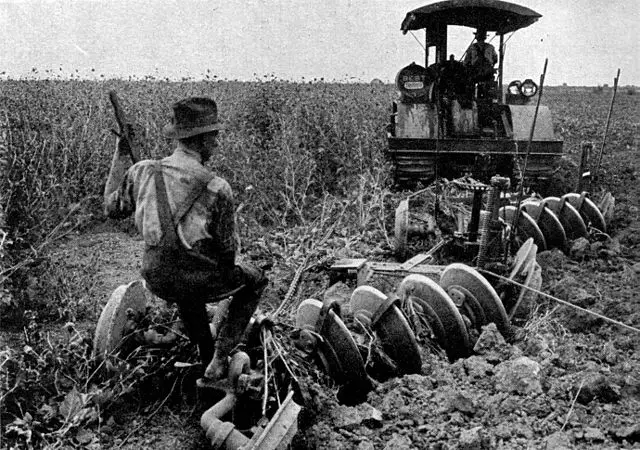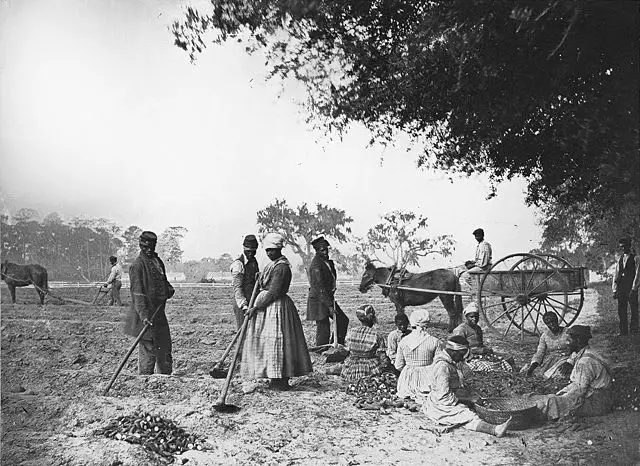Farm life
Jobs during the Colonial times included having a trade, owning a plantation, being a craftsman, and being a farmer.
There were many men that owned small farms and would work both day and night in order to make sure that their families were taken care of. Some people owned large farms called plantations.
Farmer
The farmer during Colonial America times was a very hard worker. These farmers were required to work all year long in order to make enough money and food in order to just survive.
Life of a Farmer
A farmer of the Colonial times would wake up before the sun even came out to begin to work. A farmer had to work all during the daylight in order to make sure that they got all of their work done.
Most of the time, the wife would make breakfast very early in the morning, and the farmer and his children would work from right after breakfast until the sun went down.

The men mostly took care of the farm, raised the animals, and hunted to make sure that the family had all that they needed on the farm.
Seasons
Depending on the season would depend on the work that the farmers did. During the fall and summer, the farmer would work to make sure that they had the ground plowed and that the soil was ready to plan. They would use animals to get the soil prepared.
During the springtime, the seeds would need to be planted, and the farmers would use oxen, horses, and cattle in order to work and till the ground. They would have animals that would pull the plow so that the ground could be ready to harvest.
The field would be taken care of, and the farmer would always make sure that the ground was ready to be planted.
When it was time to pick the harvest, the farmer and his helpers would work all hours of the day in order to pick and prepare the food to be sold.
During the rest of the year, the farmer would make sure that the farm was in order and that things were fixed and up to date. If the fences needed fixed or built, the farmer would do this, and he would also make sure that the house was in good shape and that things around the farm were in tip-top shape.
The farmer also was in charge of taking care of the livestock on the farm and making sure that all of the animals were fed and taken care of.
Women on the Farm
Women on the farm also worked hard. They worked hard to make sure that the farmer was taken care of by making sure that he and his family got to eat. The women would prepare food and cook the food to make sure that there was a good meal for breakfast, lunch, and dinner.
The women also would sew clothing and make things such as curtains, candles, bedding, and whatever was needed around the house.
The women worked outside and would help to take care of the garden and prepare food that was picked so that it could be sold and traded.
Women were also required to take care of the home and the family.
Other things that women did were:
- Cooking
- Cleaning
- Taking care of the garden
- Teaching the children
Children on the Farm
Children that lived on farms were also known to work during Colonial times. The boys would go out into the field and would help their father to take care of the garden and the field. They learned from a young age how to take care of the animals and how to grow and harvest food.
The girls would also work hard, but they would usually help their mother. The mother would teach them to sew at a very young age and how to take care of the family. These girls would have skills for later in life when they had their own families.

Slaves on the Farm
There were many people that did not own slaves during Colonial America, but during the 1700s, there were slaves that began to work on the plantation. The slaves were usually only owned by the rich farmers, and the small farmers could not afford to own slaves and did most of the work themselves.
Crops
There were many different crops that were grown on a farm, depending on where the farm was located. Some of the crops included:
- Corn
- Wheat
- Tobacco
- Rice
- Barley
- Oats
- Rye
Each of these crops would be used to make something, or the farmer would take the crops and sell them for money or trade them. The crops that were sold were called cash crops.
Animals
There were also animals that lived on the farm, and these animals helped to do work on the farm, were used to make materials, and were used for food. Some of the animals included:
- Chickens
- Hogs
- Cows
- Horses
One thing with horses was that they were very expensive and so only rich farmers and plantation owners were lucky enough to have a horse. The great thing about the horse was that it was very strong and able to work and be used for transportation.
More Facts About Farm Life:
- There was usually a building on the farm that would be like a small barn that was used to hold crops, tools, and animals.
- Farming was hard because the farmers did not have the tools that they needed, and they only had basic tools such as hoes.
- When the soil was tilled, the farmers had to work day and night in order to keep the plants watered, and most of them did this by hand.
- Farmers worked hard to weed their land so that the weeds would not take over the crops.
- Places in the south had better soil than those in the north.
What Did You Learn?
What was farming like during the Colonial times?
Farming was hard and was not easy work. Men, women, and children all helped take care of the farm.
Did the men do different things than the women did on the farm?
Yes. Women were required to do most of the work in the homes and take care of the children, and the men did most of the hard things on the farm.
Why was farming hard?
Farming was hard because the farmers did not have the tools like we have today and only had simple tools to take care of the fields.
Were there animals on the farm?
Yes. Farmers would raise animals to eat, use for materials, and to use to help on the farm.
How often did farmers work on the farm?
Farmers would work from sunup to sundown and all year long to make sure that the farm was ready to make food.
Were the crops different?
Yes. Depending on where you lived, rather in the north or the south, would depend on what crops were grown.



